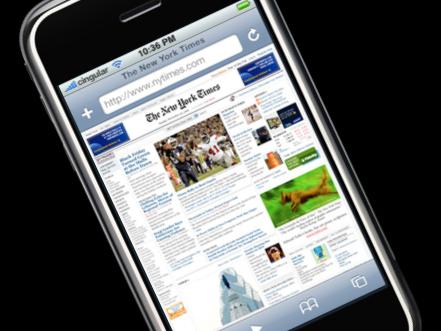iPhone: Is EDGE really good enough?
Cutting edge or yesterday's tech? We ask those in the know

So the iPhone works on O2's EDGE network. But what is it? And is it actually any good? The iPhone has been designed to work on GPRS, EDGE and Wi-Fi networks but doesn't include 3G support, something Steve Jobs has previously said is to do with the power requirements of the 3G chip.
EDGE provides higher download speeds than the 2G network and GPRS (2.5G) but less than can be achieved with Wi-Fi and 3G. As such, it has been untidily labelled 2.75G.
As for UK EDGE coverage for the iPhone, when we asked O2 about it they were, well, edgy. A spokesperson told us that geographical coverage is currently at 30 per cent. That's somewhat disappointing as that's what we were told at the UK iPhone announcement some two months ago. Indeed, it was the rapid deployment of a UK EDGE network that led to O2 being so strongly linked with the iPhone before the announcement.
Politely informing us that EDGE coverage was only available in "major conurbations...rising to 40 per cent at Christmas," our O2 spokesperson was keen for us to talk up the iPhone's Wi-Fi compatibility and its deal with The Cloud for free hotspot access.
Lack of information
And industry analysts would appear to be in the dark nearly as much as we are. "The only thing we know is that they have promised 30 per cent population coverage at launch, with growth from there at an unspecified rate to an unspecified ceiling," Ovum's wireless director Martin Garner told us.
"Even if you look at their coverage maps there's no useful information about EDGE coverage." O2's spokesperson told us there were no coverage maps as EDGE is "being updated so rapidly".
"We hear a lot from vendors and some operators that EDGE is a relatively minor and inexpensive upgrade, compared to other technologies," explains Garner.
Sign up for breaking news, reviews, opinion, top tech deals, and more.
"But it's presumably a fairly expensive thing to do if you're only serving iPhone users." The O2 spokesperson told us that upgrading a network for EDGE is "a software update rather than anything else." But that begs the question, why can't they do it even faster?
Back in September analyst Garner had hit out at the lack of EDGE coverage, saying that it "will frustrate a lot of users" if they took their iPhones out of well-populated areas. "We have seen operators launch in the UK before with very limited network coverage (One2One, 3) and it's a fairly major obstacle."
What's it like to use?
But is there a real problem with EDGE as a browsing technology? We asked Eli Mahal, vice president of marketing at mobile browsing expert Flash Networks.
"EDGE technology does not have the same speed or performance as can be expected from 3G networks. The latency can be significantly higher. There are, however, optimisation techniques that can be implemented as in-network solutions by operators that can help improve the user experience."
"EDGE offers an experience slightly faster than, but not dissimilar to, dial-up PC speeds," explains David MacQueen, senior mobile analyst at Screen Digest. "Although it can in theory achieve faster speeds, the high latency and other aspects of mobile data networks mean that it does not offer a broadband-like experience.
"However, the iPhone is designed to download 'rich' content such as music via a home computer, not over the mobile network. It will use the mobile networks almost exclusively for browsing the internet, so the speed EDGE offers will be adequate."
Early days
And as for the longer term performance of O2's EDGE network, Mahal says it really is too early to tell. "The coverage is highly dependent on the network and the level of demand. The number of iPhone users initially will probably not have an immediate impact on the network," he added.
McQueen agrees. "O2's projected 200,000 extra users as a result of the iPhone is almost a drop in the ocean - the O2 network handles 18m users today and their subscriber base typically grows by over a million users annually, so the network is unlikely to have any problems as a result of the iPhone."
But Mahal believes we may see some service degradation. "As iPhone and other phones that improve the browsing experience increase in usage we can expect some degradation in service during peak hours," he warns. "Data reduction techniques that can reduce network loads by 40-50 per cent can minimise the impact of increased traffic on the user experience."
When we spoke to an O2 insider last month, he suggested that "iPhone customers will do most of their mobile internet business over Wi-Fi," adding the handset would give a "great experience" when doing less data-heavy web browsing.
Dan (Twitter, Google+) is TechRadar's Former Deputy Editor and is now in charge at our sister site T3.com. Covering all things computing, internet and mobile he's a seasoned regular at major tech shows such as CES, IFA and Mobile World Congress. Dan has also been a tech expert for many outlets including BBC Radio 4, 5Live and the World Service, The Sun and ITV News.